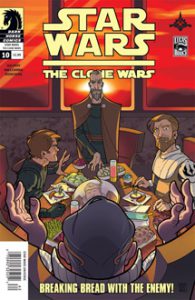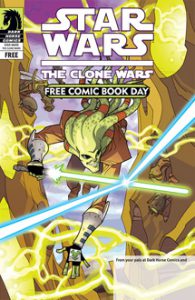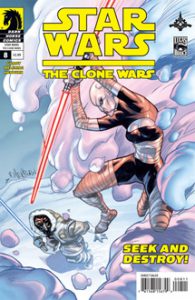“The Clone Wars” numbered comics series had a surprisingly short run of only 12 issues, but it was a good one, with TV show writers Henry Gilroy and Stephen Melching penning three arcs that could’ve been TV episodes. Indeed, “Slaves of the Republic” (Issues 1-6) was adapted into a Season 4 arc. (Because of tweaks such as Ventress being dropped from the story, as Dooku had dismissed her by Season 4, that arc is a rare example of a Legends story that was rendered non-canon within Legends – ironically because it was repurposed.)
The two three-issue yarns that follow are comfortably familiar tales where the Jedi go on a mission to a planet that is freshly caught in the Republic-Separatist war due to a natural resource or specialized industry, and both feature key continuity points for the wider saga. “In Service of the Republic” (Issues 7-9, 2009) is notable for telling the earliest-on-the-timeline story of Ozzel, later known as the Imperial admiral who is “as clumsy as he is stupid” in “The Empire Strikes Back.” Palpatine – through indifference or racism or both – praises Ozzel at story’s end for the successful mission on Khorm – although it’s actually popular clone character Wolffe (who loses his eye in this story) and Jedis Kit Fisto and Plo Koon who get the job done in spite of Ozzel.
While there’s never much doubt of where the story’s going, Gilroy and Melching pepper in some nice homages like a weather-control station reminiscent of the Tagge Corporation machine that created a path through Yavin’s atmosphere in the Marvel comics, and the snow-worms from the Pizzazz magazine comics. Depth comes from the Jedi teaching the clones the value of respecting their dead (something that sets them apart from the Seps), and humor comes from Kit and a clone constantly wondering what Plo Koon’s age is, as the old Master deftly dodges the questioning.

The “In Service of the Republic” trade paperback includes Gilroy’s 2009 Free Comic Book Day story “The Gauntlet of Death,” which is inconsequential but includes a couple interesting elements. It shows Geonosians fighting for the Separatists off their own planet; Geonosians rarely leave their home, although it’s not unheard of in Legends. (In Disney’s “Rebels,” I believe the species is wiped out by the Empire.) And we learn that their weapons’ beams can’t be deflected by lightsabers, which leads to Kit’s conundrum as he attempts to run their gauntlet. This might’ve been worth exploring in a bigger story. Additionally, Cooker is known as one of the elite clone snipers, but he only appears in this tale.
Gilroy and Melching step up their game in “Hero of the Confederacy” (Issues 10-12, 2009-10), which – as the title suggests – shows the perspective of a decent-hearted, freedom-fighting Separatist several months before the TV show did the same with “Heroes on Both Sides.” While the latter is a better story thanks to the Ahsoka-Lux near-romance, this one is strong, too, as Anakin befriends fellow podracing enthusiast Tofen Vane on the planet Valahari. (Recalling a cliché from the Marvel comics, Tofen is the son in the planet’s ruling family.)

The planet comes to the Republic’s attention for its production of vulture droid fighters, which feature in the opening battle of “Revenge of the Sith.” Also calling to mind that sequence: Tofen’s starfighter’s equivalent to an Artoo unit is a sympathetic buzz-droid, and Anakin’s yellow-and-blue starfighter is introduced here after he crashes his previous one.

Tofen and his Raiders are manipulated into serving the Separatists by Dooku, naturally. While we can again see where the story is going, “Hero of the Confederacy” is an airtight example of how someone can be drawn into one side of a war based on anger, shoddy information and willing blindness to the other side’s case. Anakin’s sadness over Tofen’s demise at the end seems more legitimate than other stories with one-and-done acquaintances.
While the art on “The Clone Wars” is consistently inferior to “Republic’s,” colorist Michael E. Wiggam does vibrant work here when the fight moves to a nebula where Tofen’s Raiders do battle with Anakin and his squadron.
These comics were full-size but collected into trade paperbacks that are digest-sized. I didn’t care for the small font size in the digests. If memory serves, that is rectified in the 11 “The Clone Wars” digests that follow, which were specifically designed for the format. But I also remember those digests having simpler storytelling.
As for the 12 proper issues of “The Clone Wars,” fans of the TV series will want to pick them up and – in the case of Issues 7-12 — imagine they are watching TV episodes that never came to be.

